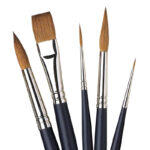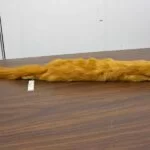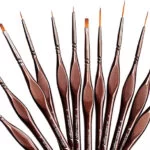How to care for kolinsky sable brushes | Do’s and Don’ts

Kolinsky sable brushes are some of the best brushes for painting miniatures because their bristles are high quality than synthetic brushes.
However, they can be a pain to care for since they are way easier to damage and break, and the bristles don’t work the same as synthetic brushes.
If you want to buy a Kolinsky sable brush to paint your miniatures, you need to learn how to care for your sable brushes so the bristles won’t damage easily.
What exactly is kolinsky’s sable?
Since this paintbrush has the word “sable” in its name, most people will think its bristles are obtained from an actual Marten sable. However, the Kolinsky sable brush is quite unique.
The Kolinsky sable brush is a paintbrush fashioned from the tail of the kolinsky sable, a Siberian weasel typically found in northern China and Russia. Their bristles often have a pale red color with dark tips.
When painting miniatures or scale models, they work effectively for glazing acrylic paints.
What you shouldn’t do with a kolinsky sable brush
- Avoid contrast paints and washes
Don’t use contrast paints or washes with a Kolinsky sable brush. These paints have a chemistry that can easily break the surface tension of your brush as they travel from the bristles to the belle and seep into the ferrules. When the paint dries in the ferrules, it makes your bristle ends split and shoot out.
- Keep paint on the tip of the brush
Try to avoid getting the paint below the bristles and down to the belle of the brush. The belle gives the shape of the brush. So, as soon as paint gets to the belle area, it means the ferrules will be affected. Thus, making the bristles stick out.
- Avoid metallic and texture paints
Don’t use metallic paints or texture paints with a kolinsky sable brush. The metal flakes or whatever pigment that gives the paint a reflective sheen and texture ruins the brushes faster than contrast paints or washes. A kolinsky sable brush is made with natural weasel hair, and like human hair, getting paint out with lots of flakes or sand can be tiring. Besides this, texture and metallic paints can be difficult to wash off the brush.
- Don’t use them with oil and enamel paints
oil and enamel paints require harsh thinning and cleaning agents that may damage the brush. More than this, oil painting involves a back-and-forth movement with hard pressure to make them sit well on the miniature, and kolinsky sable brushes don’t work well with force. So, consider getting cheap synthetic brushes for your oil and enamel paints.
- Don’t leave the brush upside down
When painting, don’t leave the brush upside down in the cup with water, not even for a few seconds. Doing so will bend the hairs or make them split.
- Avoid adding pressure as much as possible
Don’t push the tip of the brush against a solid surface. Rather, softly stipple the brush on the miniature to avoid ruining the tips.
- Don’t drybrush with a Kolinsky brush
Kolinsky brushes won’t work well for dry brushing since it requires you to force the bristles in different directions.
- Don’t dip the brush in a paint pot
Dipping brushes in a paint pot gives the paint easy access to the belle of your brush. So, avoid picking paint in pots with a kolinsky brush. Instead, use the back of the brush.
- Don’t store the brushes with leftover paint
Keep the paint from drying on the brush between coats and after painting. Rinse it before applying a new layer or storing it.
- Avoid base coating with a kolinsky brush.
With base coats, you want to get the job done as fast as possible. Kolinsky brushes won’t let you paint fast and may damage if you use them.
Use kolinsky sable brushes without damaging them
If you have a hogs hair brush, you know how easy it is to wipe the excess paint on a paper towel. Then, use a dishwashing liquid on the bristles scrubbed in the palm of my hand, and the brushes seem to hold up fine. However, sable brushes do not take kindly to abusive use.
The best way to use them without damaging them is to avoid scrubbing the bristles vigorously on your palm and spend a bit longer repeating the lather and rinse cycle so that excess paint easily gets out.
Clean your kolinsky sable brush correctly
Kolinsky sable brushes work better with watercolor and acrylic paints, but that doesn’t mean you want to let paints dry in the brush and store them.
Acrylic paints are designed with acrylic resins, which polymerize and stick hard to the bristles, and once the paint dries, it becomes difficult to remove them from the brush without damaging the natural hair.
So, before storing your Kolinsky sable hair brush, here is what you need to know.
What cleaning agent to use on Kolinsky brushes?
Technically, when you finish painting, you need to use a brush soap like the Masterson or Davinci and water to help get rid of leftover pigments in the brush.
This brush soap serves as a soap and moisturizer for your natural kolinsky sable brushes.
However, some good cleaning agents you can consider are the Winsor and Newton brush cleaner and restore, Vallejo’s brush cleaner or the Jo Sonjas brush soap and conditioner.
These cleaning agents don’t just help dissolve paints but also restore rough bristles to a fine pointy form.
Remove paint excesses to avoid damaging the bristles of a kolinsky sable
You don’t want to leave paint excesses on your kolinsky brush after painting as it might damage them. So, after dipping the brush in water and you still get paint excess on it, here’s what you should do:
- Dip the brush in water for less than a second
- Spin its hairs on the brush soap in a circular motion. When you do this, the excess paint pigments coat the top part of the soap. So, get a rag and clean it.
- Repeat both steps until you can’t see any paint on the soap
- After this, be sure to spin the paint backward at a 45-degree angle to remove paint sitting further up the back of the brush. Do this gently.
- Rinse, reshape and dry
How to dry kolinsky sable after washing?
A good way to dry a kolinsky sable brush is to run the bristles over a soft rag or paper towel.
Avoid standing the brush with its tip up when wet because the water residues on the bristles and ferrule will flow to its wooden handle, which absorbs the water, loosen the glue that holds it in place and ultimately damage the brush.
Store kolinsky sable brushes correctly
If your brushes come with plastic tip covers, the perfect way to store the bristles of your kolinsky sable brush is to cover them with a protective sleeve.
These plastic covers keep the brush from touching any surface that might damage them. Then, store them in an upright position.
Should all kolinsky sable brushes be taken care of the same?
Whether you get your kolinsky brushes from brands like Raphael or Davinci, Kolinsky brushes are all handmade with the natural hair of a Siberian Weasel. Hence, they all require the same cleaning procedures.
Conclusion
Painting miniatures and scale models are often easy when using a paintbrush. Then again, for beginner painters, it may seem almost impossible to paint thinly and keep the brushstrokes to a minimum due to damaged bristles. So, if you have a Kolinsky sable brush, treat them with care. They are fragile and don’t do well with mishandling.





